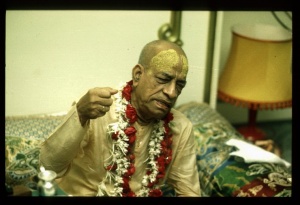SB 3.28.11

A.C. Bhaktivedanta Swami Prabhupada
TEXT 11
- prāṇāyāmair dahed doṣān
- dhāraṇābhiś ca kilbiṣān
- pratyāhāreṇa saṁsargān
- dhyānenānīśvarān guṇān
SYNONYMS
prāṇāyāmaiḥ — by practice of prāṇāyāma; dahet — one can eradicate; doṣān — contaminations; dhāraṇābhiḥ — by concentrating the mind; ca — and; kilbiṣān — sinful activities; pratyāhāreṇa — by restraining the senses; saṁsargān — material association; dhyānena — by meditating; anīśvarān guṇān — the modes of material nature.
TRANSLATION
By practicing the process of prāṇāyāma, one can eradicate the contamination of his physiological condition, and by concentrating the mind one can become free from all sinful activities. By restraining the senses one can free himself from material association, and by meditating on the Supreme Personality of Godhead one can become free from the three modes of material attachment.
PURPORT
According to Āyur-vedic medical science the three items kapha, pitta and vāyu (phlegm, bile and air) maintain the physiological condition of the body. Modern medical science does not accept this physiological analysis as valid, but the ancient Āyur-vedic process of treatment is based upon these items. Āyur-vedic treatment concerns itself with the cause of these three elements, which are mentioned in many places in the Bhāgavatam as the basic conditions of the body. Here it is recommended that by practicing the breathing process of prāṇāyāma one can be released from contamination created by the principal physiological elements, by concentrating the mind one can become free from sinful activities, and by withdrawing the senses one can free himself from material association.
Ultimately, one has to meditate on the Supreme Personality of Godhead in order to be elevated to the transcendental position where he is no longer affected by the three modes of material nature. It is also confirmed in Bhagavad-gītā that one who engages himself in unalloyed devotional service at once becomes transcendental to the three modes of material nature and immediately realizes his identification with Brahman. Sa guṇān samatītyaitān brahma-bhūyāya kalpate (BG 14.26). For every item in the yoga system there is a parallel activity in bhakti-yoga, but the practice of bhakti-yoga is easier for this age. What was introduced by Lord Caitanya is not a new interpretation. Bhakti-yoga is a feasible process that begins with chanting and hearing. Bhakti-yoga and other yogas have as their ultimate goal the same Personality of Godhead, but one is practical, and the others are difficult. One has to purify his physiological condition by concentration and by restraint of the senses; then he can fix his mind upon the Supreme Personality of Godhead. That is called samādhi.